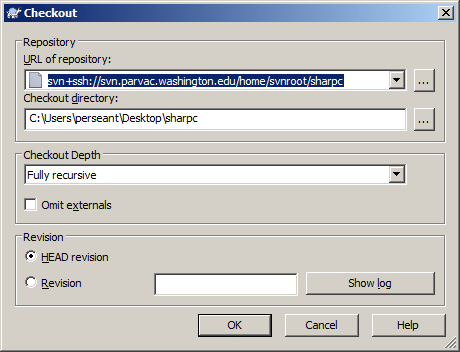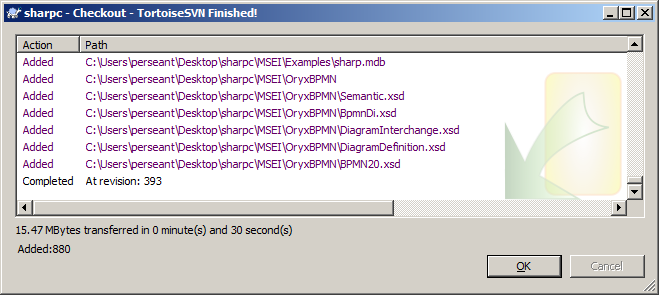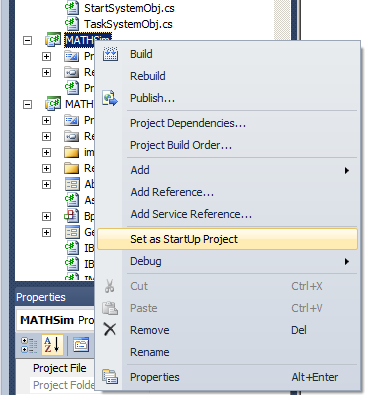$Id: compile-mathsim.html 502 2011-08-18 19:02:42Z perseant $
Getting and Building MATH
These are instructions on how to get the source code and documentation
for MATHSim and MATHView (and, to some extent, MATHFlow) from the PARVAC SVN
revision control repository, assuming you are running some version of
Windows.
What is presented here is a very brief overview of the
Subversion revision control system, the Microsoft Visual Studio
IDE, and the WiX installer builder.
See Further Reading
at the bottom for more information on these
systems.
Prerequisites
To get the source code from the repository, you will need
TortoiseSVN. To compile MATHSim, you will need the Visual Studio 2010
IDE. To compile MATHView, you will need NetBeans IDE. To build the
MATHSim installer, you will need WiX 3.5.
These packages can be acquired from the following sources:
- TortoiseSVN
- http://tortoisesvn.net/downloads.html
- Visual Studio 2010 (IDE)
- http://www.microsoft.com/express/Downloads/#2010-Visual-CS
- WiX
- http://wix.codeplex.com/releases/view/60102 (choose "Wix35.msi").
- NetBeans (IDE)
- http://netbeans.org/
After installing these four software packages, you should reboot
your computer.
Check Out a Copy of the Repository
The source code and documentation are located in a Subversion
repository on svn.parvac.washington.edu. To communicate with
this server, we use the TortoiseSVN client software.
Before we can do anything else, however, we must first obtain a
"checked out copy" of one of the folders that the server
maintains.

- Right-click on the desktop (or in any folder you like, really) and pull
down to "SVN Checkout...".
- For "URL of repository", type in our repository URL:
svn+ssh://svn.parvac.washington.edu/home/svnroot/sharpc
- Press OK. You will be prompted for a login and password, perhaps
as many as three times. This doesn't mean that you typed it wrong
the first time, only that it needs it again for whatever
reason.
- You should see a window listing all the files that were checked
out; and the new folder what will have appeared on your desktop
should have a green check mark on it. I'm going to call this
folder
sharpc
.

Once this procedure has been completed, TortoiseSVN will remember
what server it should talk to about the folder sharpc, if and
when you decide to update its contents from the server, or if you have
made changes to it that you think should be reflected on the
server.
Update an Existing Copy of the Repository
If at some later time you want to update the files you have checked
out to the newest revisions in the repository, right-click on the
sharpc
folder, and select "SVN Update". Once again you
will be prompted for a login and password, and you will see a list of
files that have been updated and/or checked out afresh.
Building MATHSim
- Double-click on the MSEI.sln file, contained
in sharpc\MSEI. This should open the solution in
Visual Studio.
- You will see several projects listed in the right-hand sidebar.
Find the project titled MATHSim. If it is listed in
bold-face, that indicates that that is the
startup project
.
If it is not listed as the startup project, right-click on it, and
pull down to Set as Startup Project.
- Press F6, or select Build Solution from
the Debug menu.

Once MATHSim has built successfully, Visual Studio will also call
WiX to create an installer. The resulting installer resides
at sharpc\MSEI\MATHVisualSimulator\WiX\MathVS-Setup.msi.
Running MATHSim from Inside Visual Studio
After a successful build, you will be able to run MATHSim by
pressing F5, or by selecting Start Debugging from
the Debug menu. Note that MATHSim will run several times
more slowly in this environment than it will once it has been installed.
Building MATHView
Gephi/MATHView is written in Java using the NetBeans platform, so
the instructions for building it are somewhat different.
- Open NetBeans from the All Programs menu.
- From the File menu, select Open Project.
- Navigate to sharpc and select MathView.
- From the Projects window on the left, locate the Gephi 0.8 alpha project.
- Right-click on Gephi 0.8 alpha and pull down to Clean and Build All.
- To build a Zip file for distribution, right-click on Gephi 0.8 alpha and pull down to Package As, then Zip Distribution. (There is also an option for Installers; it doesn't work for me, but I haven't investigated why not very far.)
- The generated zip file will be in the file system, in the sharpc\MathView\dist folder.
Running MATHView from inside NetBeans
To run Gephi/MATHView from within NetBeans, click on the green triangle ("Play") button on the top tool bar.
Building MATHFlow
The instructions for building MATHFlow are the same as for building
MATHSim, except for the location of the solution file. MATHFlow's
solution file is located at sharpc\MATH\Math.sln. The
MATHFlow sources do not include an installer, and MATHFlow expects all
of its constituent parts to reside in the C:\MATH directory,
so running it from the Visual Studio debugger is also a bit more
challenging.
Looking at the Change Log
It is sometimes useful to discover what the intended changes were for
a given revision. To see these, right-click on the sharpc
folder, and from within TortoiseSVN, select Show
Log. You will be prompted for your password twice, and then a
log will appear, showing what files were changed for each revision,
and what the committer's comments were for that revision.
Further Reading
Subversion
Subversion is a concurrent revision control system used by many
open-source projects. Its most popular reference manual is at
http://svnbook.red-bean.com/.
TortoiseSVN
TortoiseSVN is the most popular Subversion client for Windows. Its user manual is avaible at
http://tortoisesvn.net/docs/release/TortoiseSVN_en/index.html.
WiX
WiX, Microsoft's first open source project, creates installers from
an XML description file. The documentation for WiX is available at
http://wix.sourceforge.net/manual-wix3/main.htm.
Glossary
- Build
- To build software is to create an executable (or more
than one, as the case may be) from the source code. Sometimes, but
not always, an installer will be built as part of the same build
process.
- Checkout
- Files that are being maintained under revision control can be
retrieved by checking them out; the analogy is that of a
lending library. In concurrent revision control systems, such as
Subversion, the user that checks out the source code does not at the
same time obtain exclusive privileges over the checked out software;
it is as though, instead of retrieving the original book from the
library, you photocopied a book that was being held on reserve. The
result of a checkout operation is a checked-out copy of the
most current revision of the files stored in the repository.
- Commit
- When a user with a checked-out copy wishes to submit changes to
the repository, he commits (or, colloquially, checks
in) the changes to the repository. The result of this operation
is that a new revision of the affected files is created, and the
current revision number is increased. In Subversion, this means that
the global revision number is increased by one.
- Commit Log
- Whenever a developer commits a change to the repository, he
provides a summary of what changes were made. These summaries, along
with a list of affected files, appear in the commit log,
which can later be used to identify potential sources of observed
regressions. The commit log is also often used by managers and other
developers, who may wish to follow the progress of the code without
having to read the code directly.
- Conflict
- When a user with local changes performs an update, it might happen
that someone else has made changes to the same parts of the same files
as the user himself. If the changes are far enough apart, Subversion
will simply merge the changes together, but if they are right on top
of one another, it doesn't know how to do that. In that case, it will
mark the affected file(s) in conflict. Subversion will not
allow files to be committed while in conflict. The user must address
the conflicting source code, and then tell Subversion that the file(s)
are no longer in conflict, before committing his changes. Since
changes to binary files cannot be merged, concurrent changes to any
binary files stored in the repository will always result in a
conflict.
- IDE (Integrated Development Environment)
- An application (or perhaps a collection of applications) that
includes at least a source code editor and a compiler. For this
project, our development environments are Microsoft Visual Studio and
Oracle NetBeans.
- Installer
- An installer is a small application whose job it is to install
software and inform the end user of the licensing conditions. The
installer contains information about each part of the software to be
installed and where it all should go on the end user's computer
(subject, usually, to their preferences).
- Local Changes
- A common misconception about revision control is that any changes
made to any local checked-out copy are automatically reflected in
every other checked-out copy. Since a significant fraction of the
development cycle involves code that does not even compile, let alone
do what it is supposed to, no sane revision control software will work
like this. Instead, individual developers work on one component to
effect one change, and when their change is working well enough to
share, they commit. Before they commit, of course, their checked-out
copy differs from what is in the repository. These changes are known
as local changes.
- Regression
- A feature which had previously worked as expected, but which no
longer works after a software update, is known as
a regression.
- Repository
- In revision control parlance, the repository is the
central location of the files under revision control.
- Revision Control
- Revision control allows organizations (as well as individual
developers) to have a historical view of source code. Past revisions
can be retrieved, or compared against the present revision or against
each other. For a single developer, this makes it possible to
identify the source of regressions, and acts as a sort of instant
backup system. In the case of multiple developers, it allows them all
to work on the same code at the same time, with a minimum of fuss.
(There is always, of course, some fuss when there are multiple
developers.) For organizations, revision control allows the
simultaneous existence of several released versions of a piece of
software, so that updates can be released for both. Revision control
also allows managers to keep track of what changes are being made to
the source code by looking at the commit log, thus freeing managers
from themselves having to read the source code.
- Update
- An update applies any changes that have been made to the
repository since the last update, to the checked-out copy. If there
are any local changes, the update will attempt to merge the changes,
possibly resulting in a conflict.



